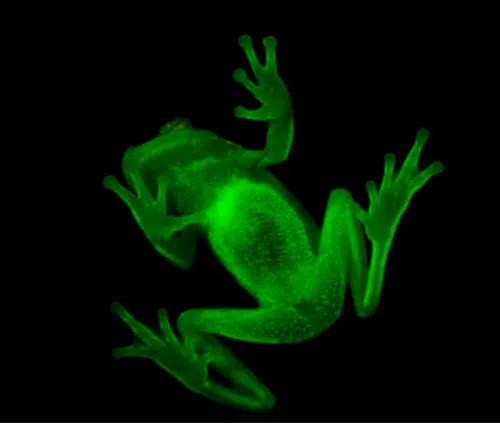Researchers have discovered for the first time a frog that glows with fluorescent colors

By Dr. Daniel Mader, Zivata, Science and Environment News Agency
Remember the merry seventies? Flashing disco lights, bouncy music, clothes that many of us would like to forget and that give us a slight shock when we look at the family photos. To be sure, those were colorful days. One animal apparently misses them so much that it decided to pay homage to the glowing disco lights: Researchers from Argentina and Brazil discovered a species of frog that glows with ultraviolet light.
At first glance, the South American spotted tree frog (Hypsiboas punctatus), is not particularly impressive. Her body is covered in dull colors of green, yellow and red, but if we just turn off the light and turn on an ultraviolet lamp, we see how the shy frog turns into the queen of the disco ball and lights up the room with fluorescent lights glowing blue and green.
Glowing at sea and on land
Fluorescence is a phenomenon in which short-wavelength, high-energy light is absorbed by certain molecules, which in response release longer-wavelength, low-energy light. For example, ultraviolet light causes the emission of blue or green light, or blue light that causes the emission of red light. Fluorescence is common in creatures that live in the sea - such as plankton, corals, jellyfish, sea turtles and fish - but is rare on land. Until now, fluorescence was only known in certain species of scorpions and parrots. There are various explanations for the reasons why the fluorescent animals developed their abilities: protection against strong sunlight, communication between individuals, and the use of certain species in fluorescent molecules as oxidation inhibitors (antioxidants).
Today, various types of fluorescent molecules are known from nature, and they are used in biological research, medicine, and more. The fluorescence in frogs originates from a new type of molecules that are not similar to the types known so far. These molecules, it turns out from the research, are found in the frogs in the lymph glands, in the skin and in secretions from glands in the skin.
The current study shows that under low light conditions, the fluorescence in these frogs constitutes a significant part of the light emitted by them (which also includes reflected light of non-fluorescent origin). Therefore, the researchers hypothesize that the fluorescence in these frogs is used for communication and can help them locate each other. There are not many differences between the fluorescence patterns between males and females - therefore the researchers assume that it is not about courtship habits. At the same time, not much is still known about the vision system of these frogs in order to draw more decisive conclusions. Anyway, at least the tree frog found a way to look good at a retro party.
